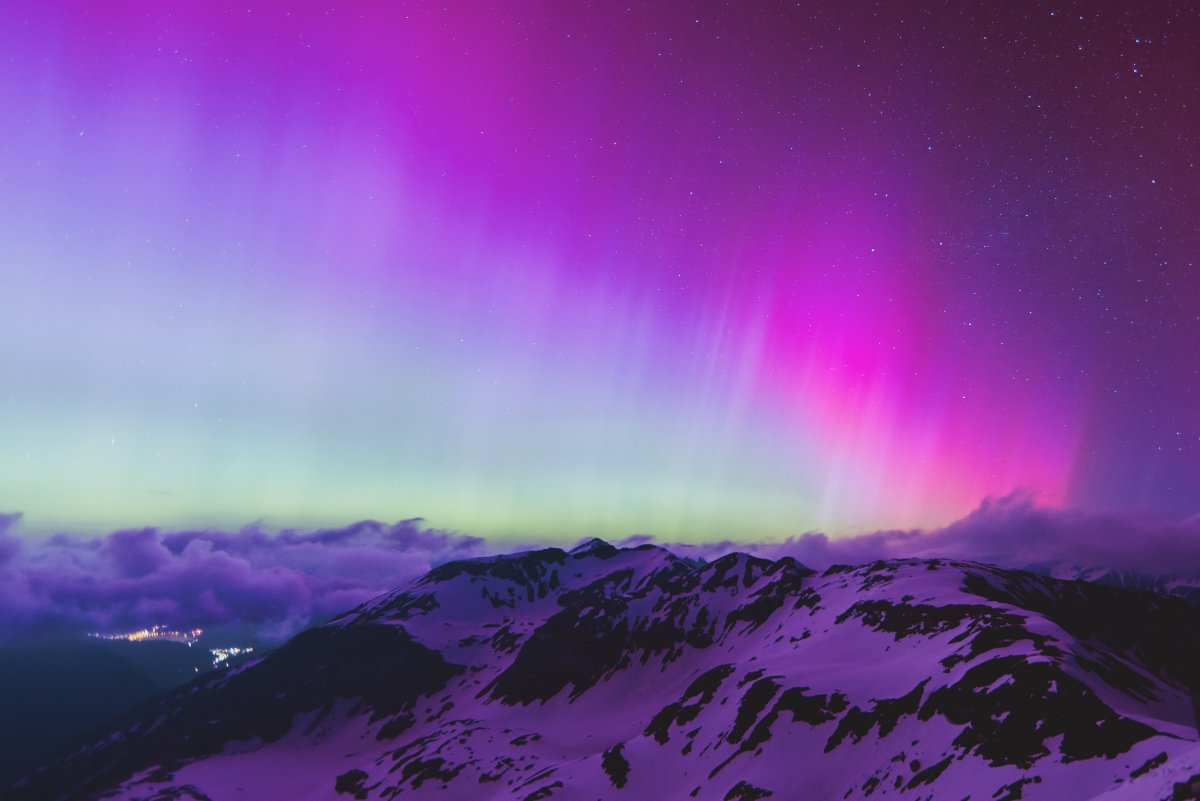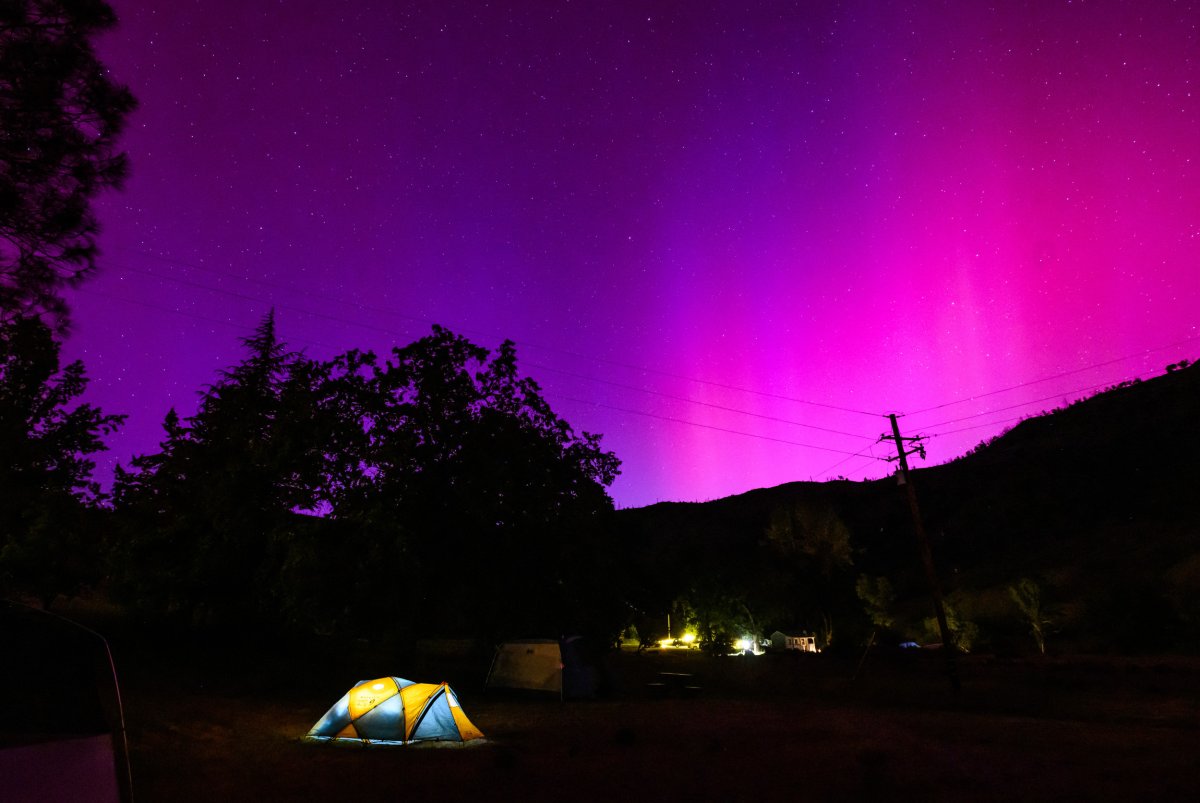Millions of people were treated to an extremely rare cosmic show as powerful geomagnetic storms triggered spectacular aurorae to erupt across the skies.
All 50 U.S. states—even Hawaii—were able to see the northern lights shimmering across the night sky on Friday night, with people as far south as Germany and Spain even catching a glimpse of the stunning phenomenon.
For the unlucky amongst us who missed the chance to see the lights, there are other ways to spot this cosmic spectacle. There may be some weak lights in the sky early this week, but these will likely be far less impressive than Friday night's show.
"NOAA has clearly indicated that the CME causing this weekend's big northern light activity has passed Earth and there is nothing more expected from them. However, there is another glancing minor blow at G1-G2 [fairly standard] expected today (May 13)," Daniel Brown, an associate professor in astronomy and science communication at Nottingham Trent University in the United Kingdom told Newsweek.
The G5 storm on Friday was the first "extreme" geomagnetic storm since 2003. Geomagnetic storms are ranked by power on a scale of G1 to G5, so this recent storm was one of the most powerful possible.

"G5 storms are very uncommon. We might expect only 3-4 of these events over the duration of a solar cycle (which lasts 11 years). Interestingly, we didn't have any G5 storms over the last solar cycle, so the G5 storms this weekend were a reminder of the power our Sun possesses," David Jess, a professor of solar physics at Queen's University Belfast, told Newsweek.
This Friday's display was sparked by a series of coronal mass ejections (CMEs) spat out from the sun in quick succession, all emanating from a particularly volatile sunspot.
"The sunspot group on the sun (which caused the G5 storm) grew to a massive size; some 15 times larger than the Earth itself! It released a number of high-energy flares while it was pointed in the general direction of the Earth, which produced multiple coronal mass ejections (CMEs). The CMEs that were ejected from the sun can travel at different speeds as they span out into space. If these CMEs reach the Earth at approximately the same time, then they can combine to produce a very large storm, like the G5 we saw at the weekend," Jess said.
This sunspot is about to slowly rotate away from us, taking Earth out of the impact zone for CMEs and solar flares, meaning that any major solar storms like those seen on Friday are unlikely to occur for the next few weeks.

"The large sunspot group is starting to rotate around the side of the sun now. By Tuesday/Wednesday it will likely be out of view. However, until then, Earth-directed CMEs from the solar flares produced by that sunspot group are still a possibility, although expectations are that the general geomagnetic storm levels will see a decrease in the coming days," Brown said.
"The sun takes 27 days to rotate, so in a few weeks we may see a reappearance of the large sunspot group, but it is unclear how active it will be this late into its life cycle."
However, even if this particular sunspot doesn't send any more CMEs our way, as we approach the sun's solar maximum—forecast to occur somewhere between now and 2026—sunspot activity and space weather are expected to get more intense. The solar maximum is part of the sun's natural 11-year solar cycle, during which the sun's magnetic field is the most distorted and solar activity significantly increases.
"As usual, the sun is always active and is running into its maximum over the next months. The NOAA expects the solar maximum to be reached around May next year. So, we are expecting more activity. But something as severe as last weekend's storm might be a one-off for this solar cycle. But that can't be ruled out entirely," Brown said.
For those who can't wait, one option is to travel to the northern latitudes where less powerful CMEs and solar weather can still trigger the northern lights. However, these are usually best observed during the winter months.

"Even the brightest auroras have a hard time competing with daylight, and places like Alaska and Iceland now have that basically 24 hours a day, at least as twilight. So don't plan a trip to northern Canada, Alaska, Iceland, or Scandinavia to see auroras in summer," Martin Connors, a professor of space science and physics at Canada's Athabasca University, told Newsweek.
"In the northern hemisphere, places like this are good in late August to about April, and then you have to factor in weather. Maybe the best combination of weather and viewing is in Yellowknife, Canada, where thousands of Japanese tourists come every year in fall and winter specifically to view auroras.
"Places near coastlines, say in Alaska, Iceland, and Scandinavia usually have poor (cloudy) weather in the dark season. Russia, curiously, is on the 'wrong' side of Earth's magnetic pole to get much aurora despite having a huge northerly expanse, so even if one wanted and was allowed to go there—not a good choice for auroras," Connors said.
For the best viewing, a clear, dark sky is required, with minimal light pollution.
"You also, of course, need clear skies," Huw Morgan, head of the Solar Physics group at Aberystwyth University in the U.K., told Newsweek.
"I would recommend checking the forecasts, and if there is an incoming event, go out on a clear night to somewhere with dark skies, far from any street lighting. Allow time for your eyes to adjust to the dark and try to have a clear view northward. Taking long-exposure images with a camera can help reveal more detail and colors than that possible with the naked eye."
Do you have a tip on a science story that Newsweek should be covering? Do you have a question about auroras? Let us know via science@newsweek.com.
Uncommon Knowledge
Newsweek is committed to challenging conventional wisdom and finding connections in the search for common ground.
Newsweek is committed to challenging conventional wisdom and finding connections in the search for common ground.
About the writer
Jess Thomson is a Newsweek Science Reporter based in London UK. Her focus is reporting on science, technology and healthcare. ... Read more





